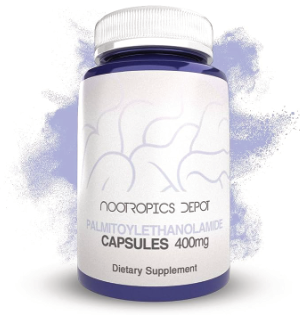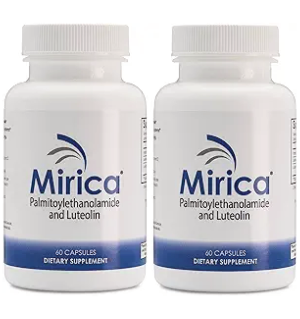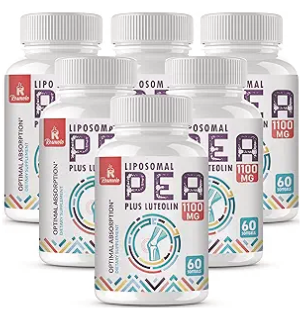
Have you heard of palmitoylethanolamide (PEA) as a glaucoma treatment? Before we discuss palmitoylethanolamide, let’s find out a bit more about glaucoma first.
What is glaucoma and why is it important?
Glaucoma is a condition where there is progressive damage to the optic nerve, usually related to high pressure in the eye. This causes visual field loss and if untreated, eventual blindness.
Glaucoma is the second commonest cause of blindness worldwide, and affects at least 2% of the population. More than 60 million people are affected globally. The scary thing is that most people do not notice any glaucoma symptoms until a lot of glaucoma damage has already occurred.
It is widely accepted that the retinal ganglion cells of the optic nerve become permanently and irreversibly damaged from glaucoma. It is this damage to the ganglion cells that eventually leads to blindness.
The conventional thinking is that any vision lost from the optic nerve damage cannot be recovered, hence the focus on monitoring and early glaucoma treatment. The idea to pick up early signs of glaucoma damage before any significant sight loss and glaucoma symptoms develop.
What is palmitoylethanolamide (PEA)?
Palmitoylethanolamide, or PEA, is a precursor to an endocannabinoid (or endogenous fatty acid amide) that is naturally produced throughout our body to reduce pain and inflammation in response to tissue damage and injury.
Wait a minute – endocannabinoid? As in cannabis and marijuana?
PEA is a similar-looking molecule to delta-9-tetrahydrocannabinol (which is the main active ingredient in marijuana). The great thing about PEA is that it has a lot of the benefits of cannabis but without any of the side effects.
This means you won’t get addicted to PEA if you decide to take oral PEA supplements. After all, it is also found in many plant and animal food sources such as milk, soybeans, egg yolk, and peanut oil.
In fact, PEA supplements have been approved in Italy as a food supplement.
The main mode of action of PEA is to bind to receptors in cells which then switch off the production of inflammatory substances. PEA also increases the levels of anandamide (a natural cannabinoid) in your body, and this helps with relaxation and pain relief.
Its potential benefits have been studied for complex pain, stroke, multiple sclerosis, depression, and even influenza.
Interesting fact: Most PEA supplements are synthetic, and hence are technically not ‘natural’ supplements.
I heard that marijuana lowers the eye pressure. Can palmitoylethanolamide reduce eye pressure too?
The short answer is: Yes!
PEA is present naturally in the eye, including in the ciliary body. The ciliary body produces aqueous fluid, and is therefore important in regulating eye pressure. Eyes with glaucoma have less PEA in the ciliary body compared to normal eyes without glaucoma.
Several clinical trials have confirmed the ability of PEA to reduce eye pressure in glaucoma.In 2011, a well-designed randomized clinical trial reported that for glaucoma patients using timolol eye drops, PEA taken 300 mg twice daily was able to further reduce eye pressure by an additional 16%.This pressure lowering effect was not seen with those taking the placebo.
Another trial published in 2011 found that pre-treatment with PEA for 15 days prevented short-term eye pressure spikes after laser iridotomy for angle closure glaucoma.
See Related: Laser iridotomy treatment for angle closure glaucoma
How else does palmitoylethanolamide work as a glaucoma treatment?
In a randomized clinical trial of 32 patients with treated low pressure glaucoma, ultramicronized PEA 300 mg taken twice daily for 6 months was able to further decrease the eye pressure from an average of 14 mmHg to 11 mmHg after treatment. This result was expected. What was unexpected was that the visual field parameters did not just stabilize – they actually improved!
These findings are very exciting, but we need to bear in mind that the trial had a very small sample size and short study duration. This means that we don’t know if most low pressure glaucoma patients will benefit from PEA, and we don’t know if the effects are maintained over the longer term.
In a separate trial, stable glaucoma patients recorded lower eye pressures when taking PEA 600 mg daily in addition to their usual eye drops, compared to when using their eye drops alone.
In this trial, PEA also improved the function of optic nerve ganglion cells (measured with pattern electroretinography) and quality of life (measured using specialized quality of life questionnaires).
Last but not least, PEA in the form of eye drops (Defluxa) has been shown to decrease dryness and inflammation of the ocular surface caused by long-term use of glaucoma eye drops.
As far as I am aware, Defluxa is currently only available for purchase in Italy.
Are there any side effects from palmitoylethanolamide?
PEA is safe and very well-tolerated. There does not appear to be any significant adverse effects or drug interactions when taken as an oral supplement.
PEA has been extensively investigated in clinical trials, with doses ranging from 600 mg to 1,800 mg daily. None of the clinical trials reported any serious risks of PEA despite the wide range of doses studied.
A few studies have used PEA in children, and no adverse effects were reported. PEA has also not been found to have any toxic impact in pregnant animals (but this has not been studied in humans).
See Related: Natural glaucoma vitamins for your optic nerve
I have glaucoma. Should I take palmitoylethanolamide anyway?
What I particularly like about PEA is its ability to reduce eye pressure and also potentially help to preserve (or even improve) the visual field and optic nerve ganglion cell function.
Since PEA also has an excellent safety profile, I am very comfortable for my glaucoma patients to take palmitoylethanolamide as a glaucoma treatment. Some ophthalmology departments in Italy already routinely recommend that their glaucoma patients take palmitoylethanolamide supplements in addition to their usual glaucoma treatments.
I think PEA at a dose of 600 mg daily will be beneficial regardless of whether you have high pressure or low pressure glaucoma. If you have advanced glaucoma, you can increase the dose to 1,200 mg daily.
Any brand of PEA is acceptable, as long as it is micronized or ultramicronized in a fine powder for improved absorption. It is the micronized and ultramicronized forms of PEA that have been studied in most of the clinical trials.
Highly-rated micronized PEA supplements are available for purchase online through iHerb or Amazon.
If you wish to take palmitoylethanolamide as a glaucoma treatment to prevent and reduce your risk of glaucoma blindness, below are highly-rated and recommended supplements that are available for you to purchase through Amazon:
Remember that PEA must not replace the glaucoma treatment that has already been prescribed by your eye specialist. Rather, it should be taken in addition to and complementary to your existing treatment.
See Related:
Medical treatments for glaucoma
Are there any other alternative natural remedies for glaucoma?
Are there any other alternative natural remedies for glaucoma?
Yes! Palmitoylethanolamide is a great glaucoma treatment. However, there are other widely available natural supplements that can be used to complement your existing glaucoma treatment.
It is worth repeating that if you are considering any of the natural glaucoma supplements and remedies, please make sure to discuss with your eye specialist and family doctor first to avoid adverse drug interactions and unwanted side effects. .
See Related:








